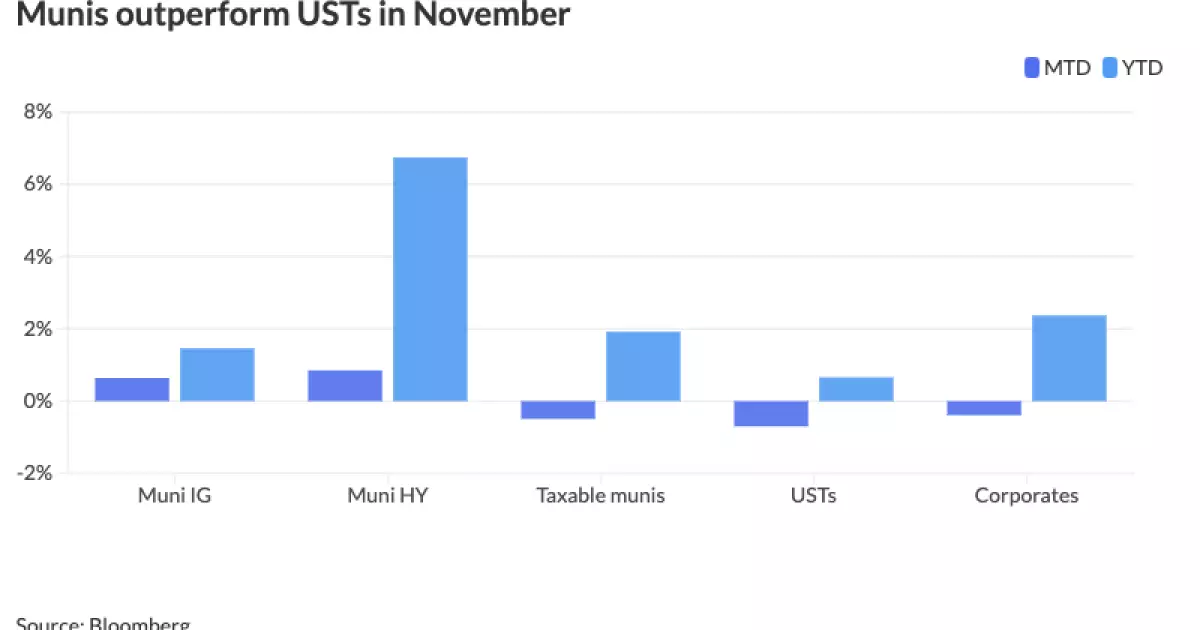The municipal bond market has emerged relatively unscathed in the face of recent volatility in the financial sector. While U.S. Treasury yields experienced slight declines, equities presented a mixed performance, indicating a complex market environment. In this context, municipalities, often viewed as safer investments, have maintained their appeal. Analysts, including Jeff Timlin of Sage Advisory, emphasize the stability of municipal bonds compared to U.S. Treasuries, particularly during uncertain times.
Stability Amid Market Turmoil
Traditionally, the municipal bond market is not the first avenue for tactical investment maneuvers, unlike other sectors such as USTs, which investors may leverage for short-term gains linked to political events or broader market trends. As Timlin suggests, this conservative nature of municipal trading has allowed it to serve as a more reliable asset during periods of heightened market volatility. With economic indicators fluctuating, investors seem to be gravitating towards municipal bonds, viewing them as a refuge in uncertain times.
Pat Luby, from CreditSights, corroborates this sentiment, pointing out a slight decline in municipal yields, which reflects active buying in the primary market. Investments are flowing into municipal mutual funds and ETFs, indicating a robust appetite for these securities. An impressive trend shows that municipal mutual funds have seen a sequential 20 weeks of positive inflows, showcasing investor confidence in these assets.
The Flow of Funds
Although fund inflows are trending positively, a noteworthy observation is the slowing growth in these inflows. Investors contributed approximately $305 million in the week ending Wednesday, a significant decrease from the previous week’s influx of $1.264 billion. This slowdown raises questions about future investment behaviors and highlights an evolving landscape for municipal bonds. Timlin predicts that while fund flow levels may stay stable, they are likely to remain within a “fairly tight boundary” in the foreseeable future.
In comparison to U.S. Treasuries and corporate bonds, municipal bonds have outperformed significantly. The ratios of municipal bond yields to USTs have fallen, indicating the market’s confidence in their value. For instance, the two-year municipal to UST ratio was reported at 62%, revealing a favorable comparison for municipal investments.
The upcoming week promises to be dynamic for the municipal bond market, with an estimated issuance of $8.4 billion on the horizon. Notable deals include $1 billion in revenue bonds linked to United Airlines, signaling strong activity in the transportation sector. The municipal community typically anticipates heightened issuance ahead of holiday seasons, and this week is no exception. Issuers are capitalizing on favorable conditions to finalize their offerings, as Timlin notes that many aim to complete business before Thanksgiving.
Daryl Clements from AllianceBernstein expresses confidence in demand and believes that the supply will be “well absorbed” by buyers. This optimism is further supported by significant upcoming bond issues, such as Connecticut’s $1.38 billion in special tax obligation bonds and the Greater Orlando Aviation Authority’s $843 million in airport revenue bonds, both set to price soon.
While municipal bonds have held their own, the broader yield environment remains crucial in understanding market dynamics. AAA-rated municipal bonds showed little fluctuation, with the one-year rate resting at 2.79% and the 30-year at 3.79%. Comparatively, UST yields exhibited minor reductions across various maturities, suggesting that investors are weighing their options between different long-term investment vehicles.
These movements in rates are particularly relevant when evaluating the health of municipal bonds relative to other asset classes. Lenders and borrowers alike should monitor these nuances as they could impact financing costs, investment strategies, and overall market attractiveness.
The Changing Landscape Ahead
As we approach the end of the year, the municipal bond market will continue to face challenges and opportunities. Strong demand amidst an evolving economic backdrop might lead to fluctuating yields, impacting municipal bond valuations. Investors will need to stay informed regarding market trends, including monetary policy changes and regional financial health, which could further influence the environment.
While the municipal bond market has shown resilience during turbulent times, remaining vigilant and adaptable will be essential for investors looking to navigate the complexities of this sector. The interplay of market confidence, strategic issuance, and consistent fund inflows could provide a promising outlook, but uncertainty remains an ever-present factor in the financial landscape.


Leave a Reply